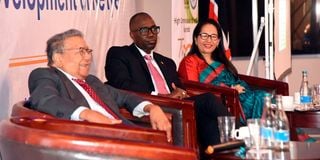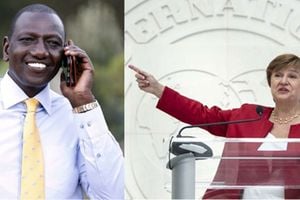Kenyan Indians: A story of struggle and triumph

Kenyan industrialist and philanthropist Manu Chandaria (left), Foreign Affairs Principal Secretary Singoei Korir (centre) and India High Commissioner to Kenya Namgya Khampa during the Kenyan Indians conference at Movenpick Hotel in Nairobi on Tuesday last week.
India and Kenya have this month been marking separate fetes. While Nairobi commemorated 60 years of internal self-rule, New Delhi is celebrating 75 years of independence from British rule.
Yet, in spite of the distance between them, a fabric has been woven linking them for more than 120 years. On Tuesday, the community of Indians, whose families arrived in Kenya in the 19th century, gathered in Nairobi to discuss how their Indian ancestry has fuelled their industry and unity in Kenya.
“The Asian story has not been written,” said Industrialist Manu Chandaria, 94, also known for his philanthropy.
“Their contribution is not just for creating wealth in this country. Their contribution goes to the time of difficulty when no roads existed and wild animals roamed. The contribution of Asians is not to be told or described. It is visible.” Mr Chandaria spoke at a workshop dubbed “Kenyan Indians’ Contribution to the Development of Kenya” and organised by the Indian High Commission in Nairobi with the United Asian Network, a lobby of the Asian community in Kenya who trace their roots to India. The name, Kenyan Indian, itself may be controversial.
The people gathered in a hall at Movenpick Hotel in Nairobi fully identify themselves as Kenyans without the additional tag. A few years ago, the government formally recognised Asian Kenyans as the 44th tribe. When their forefathers first set foot in Mombasa to help build the Kenya-Uganda Railway, even their own country back home had not been created yet. Instead, it was generally known as the ‘Indian subcontinent’ due to similarities in the culture across today’s India, Pakistan, Nepal, Bangladesh and Sri Lanka. The railway builders, who arrived from 1888, were mostly from Punjab. But they beat a path that most other Indians followed later, working as traders, teachers, builders, doctors, lawyers and even journalists.
At the forum in Nairobi, names such as Pio Gama Pinto, the assassinated freedom fighter, Makhan Singh, a political prisoner, hockey legend Mahan Singh, educationist Malkiat Singh and rally legend Jonginder Singh and Alibhai Mulla Jeevanjee were celebrated for their role in shaping the economy, culture and politics of Kenya.
“We believe that a reckoning of India’s post-independent journey cannot be complete without reference to India’s diaspora. It is a true tie of friendship between India and the countries they live in,” said Indian High Commissioner to Kenya, Ms Namgya Khampa.
“I am often amazed at how Kenyan Indians have kept their identity while at the same time adopting to their Kenyan culture.”
In some cases, its it those they found here that copied their style, including in cuisines. Foreign Affairs Principal Secretary Korir Sing’oei narrated his childhood story in which they shopped from an Indian shop, had masala tea, chapati and spiced rice stew, originally from Asia. Because many Kenyans assumed these had always been around, he noted, few people gave Indians the deserved credit.
“The question of measuring the contribution of a community is a very difficult thing to do,” Dr Sing’oei told the audience.
“One has to appreciate that, when you see the same result of success coming up from the same group, you begin to wonder if there is something in their background. You came here with nothing but you have made something out of nothing.” The story of Indians’ immigration into Kenya in the pre-colonial period is a tale of toil, death and survival.
“Most of the Indians came here with nothing. They just wanted to survive,” said Mr Chandaria. “Some walked on foot from Mombasa to Nairobi. Some were attacked and eaten by lions of the Tsavo. The amount of sacrifice is beyond belief.”
Mr Chandaria was narrating the story of his own parents, who moved to Kenya in the early 1900s to start a shop along today’s Biashara Street in Nairobi. Today, he said, Asians’ contribution to Kenya needs to be looked at beyond just the ‘dukas.’
“Kenya has given us lots of opportunities and lots of challenges. And the Asian community has never stopped dealing with those challenges. It is up to us to continue building what our forefathers started,” Mr Chandaria told the audience at the forum.
The Indian government is seeking to strengthen ties between it and Kenya as well as other countries with a huge population of people of Indian decent.
Ms Khampa said her government was riding on those cultural ties to also boost other relationships. One way of doing that was through Kenyans who were not of Asian descent but attended school in India.
The pool is now forming part of the United Asian Network, an organisation launched three months ago to connect people who identify themselves with India in one way or another.





